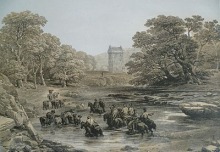Just like the Highlanders, the Borderers were organized into clans led by chiefs. These clans survived through cattle-raiding, waged blood feuds with each other, and commemorated the deeds of their heroes in song. However, the songs in question were in Scots or Northumbrian English rather than Gaelic. Some people refer to these Border clans as “families” or “names” in order to arbitrarily distinguish them from Highland clans, but they were explicitly referred to as “clans” in Scottish legal documents during their own era.
It is clear from the names of the clans themselves that they were not of Gaelic origin. Border clans have names like Maxwell, Johnstone, Armstrong and Nixon, none of which carry any hint of Gaelic.
This is interesting in historical terms because so many people see clans, clan chiefs, cattle-raiding and blood-feuding as Gaelic or “Celtic” characteristics, yet all these things thrived along the Border among people who were not Gaelic at all. Clan systems develop when central government is weak, ineffective and/or distrusted, leading people to band together for protection. They are not a defining feature of “Celticness” or “Gaelicness.”
